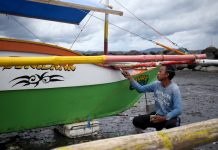At least 2,875 megawatts (MW) of renewable energy (RE) projects in Mindanao are in the indicative phase as of October 2024, data from the Department of Energy (DOE) showed.
Of the total, 1,072 MW or 37.29% are wind power projects, 701.460 MW hydro plants, 600MW natural gas, 451.53 MW solar, and 50 MW biomass.
Rapha Julysses E. Perez, science research specialist II of the DOE-Mindanao Field Office, explained that indicative power projects are still in the pre-development stage, meaning developers are undergoing studies and securing permits from government regulatory bodies, particularly for projects located in ancestral domains.
In an interview at the sidelines of the Kapehan sa Dabaw on Monday, he said the DOE hopes to attract more investors in renewable energy, as it targets to increase the share of clean sources of electricity in Mindanao’s grid to 35% by 2035 and 50% by 2050.
He said that Mindanao is within target because as of 2024, the grid consists of 69% non-renewable power and 31% renewable energy.
Perez revealed that there are 258 MW of committed RE projects. These are 90 MW and 168 MW solar power projects, which are eyed for commercial operation between 2025 and 2028.
“These committed power projects have entered the point of no return. That’s why it’s called ‘committed.’ That’s what it implies,” he said.
As of November 28, the National Grid Corporation of the Philippines recorded an available generating capacity of 3,155 MW and system peak demand of 2,393MW, or a surplus of 762 MW.
Perez stressed that the Philippines has a “bias for renewable energy” because of its commitment to reducing its carbon footprint.
Under the Paris Agreement, which entered into force on November 4, 2016, state signatories target to limit “global warming to well below 2, preferably to 1.5 degrees Celsius, compared to pre-industrial levels” as part of global efforts to combat climate change and adapt to its effects.
Under this agreement, countries “aim to reach global peaking of greenhouse gas emissions as soon as possible to achieve a climate neutral world by mid-century.”
The Philippines signed the Paris Agreement on April 23, 2016, and it was subsequently ratified by the Senate on March 23, 2017, under the administration of former President Rodrigo R. Duterte.
Perez said the new power developments in the country are mostly concentrated in renewable energy due to a moratorium that prohibits new applications for non-renewable power projects.
In 2020, the DOE declared a moratorium on endorsements for greenfield coal power plants, which prohibits new applications for the construction of coal-fired power projects.
Perez said the government also seeks to diversify the sources of power because the “more supply that we have, the cheaper electricity prices will become.”
“That’s why the power industry is deregulated to promote more players on the generation side, which will hopefully promote healthy competition that will be advantageous for the consumers,” he said. (Antonio L. Colina IV / MindaNews)






